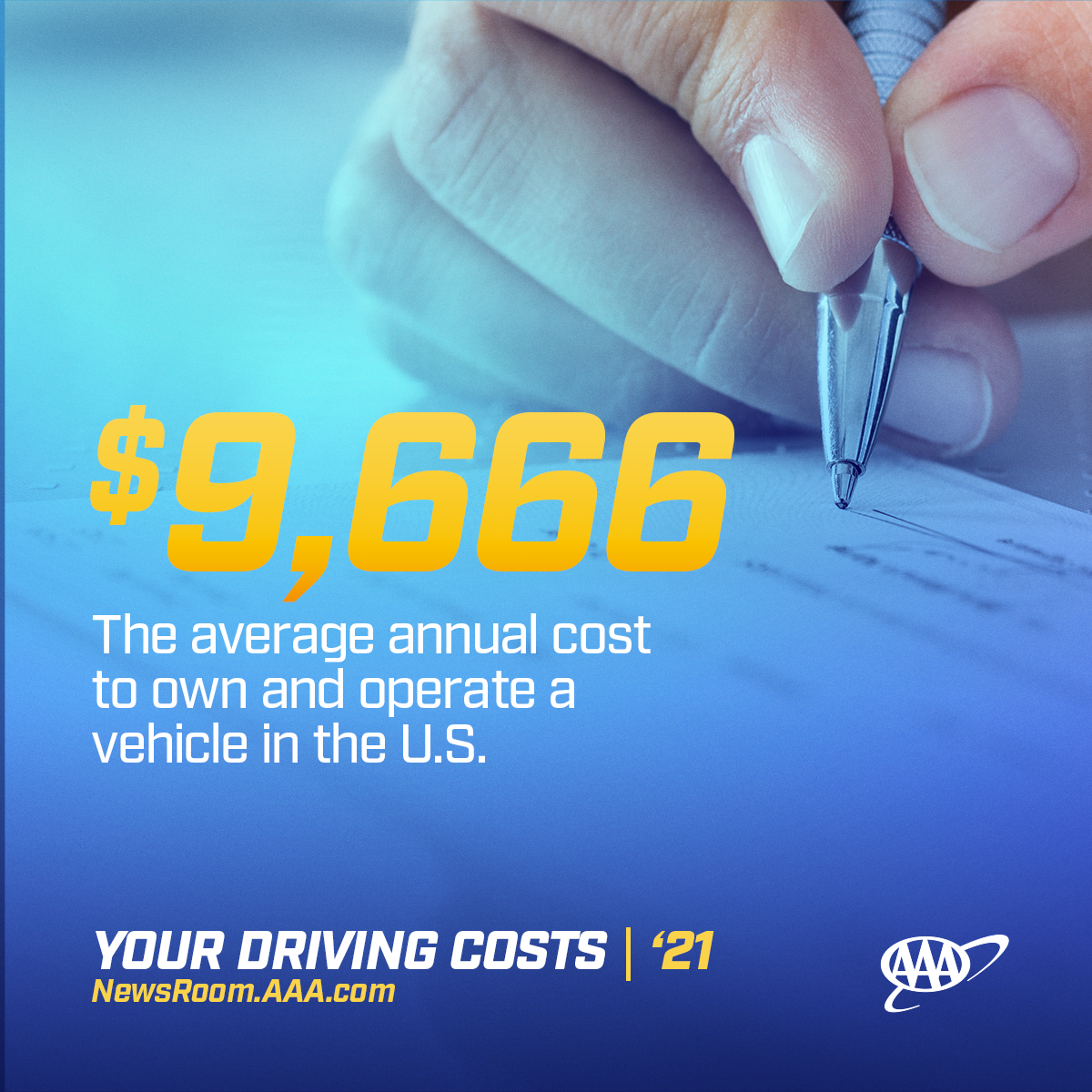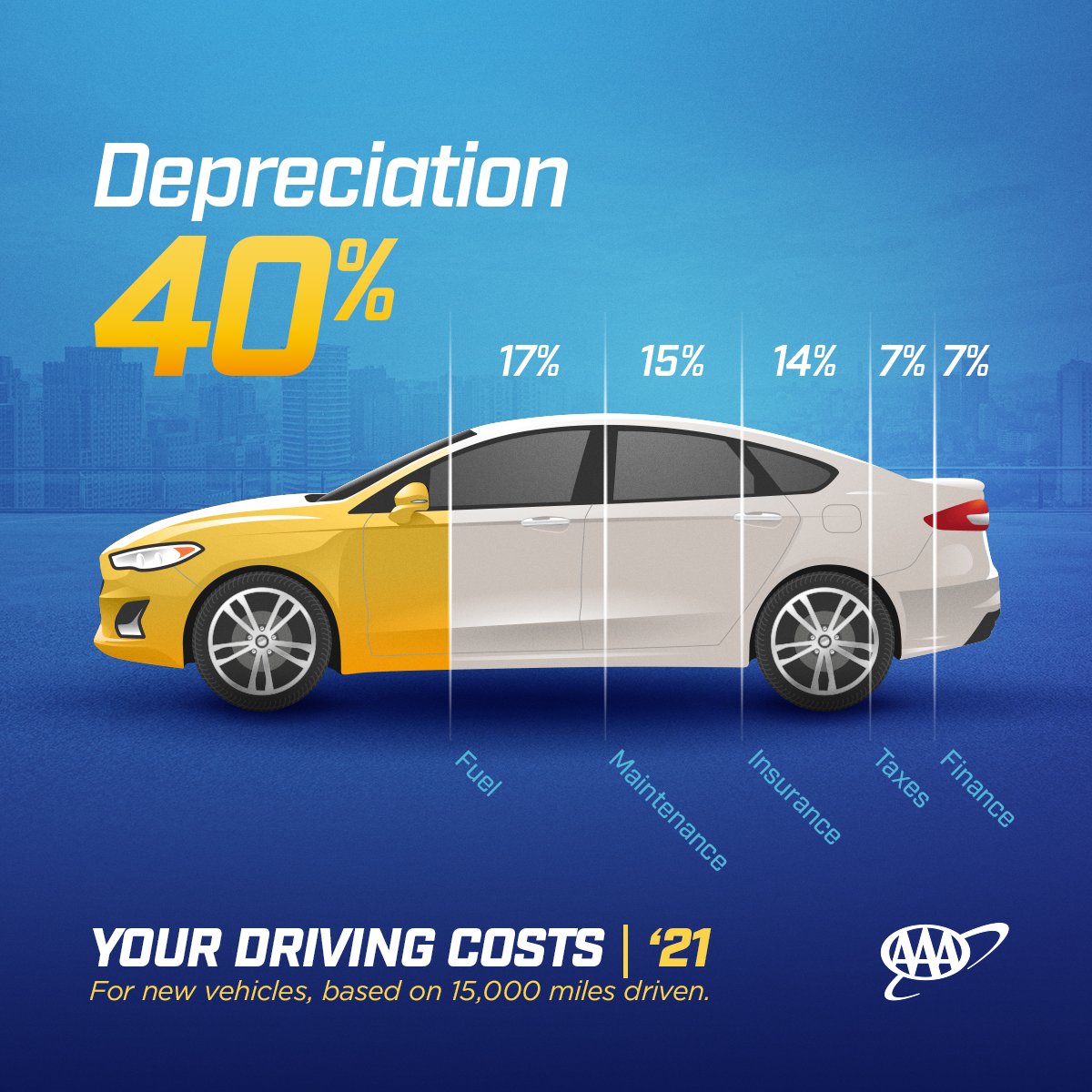PORTLAND, Ore., – AAA says the average annual cost of owning a new vehicle is $9,666 per year, or $805.50 per month. The average price of a new vehicle for 2021 is $32,903, according to AAA’s annual Your Driving Costs study.

Find details of the study in the fact sheet and Your Driving Costs brochure. AAA has published the Your Driving Costs study every year since 1950.
The biggest factor pushing the nearly $10,000 annual price tag is depreciation. It accounts for 40% of all ownership expenses outpacing costs such as fuel and maintenance.
“The saying goes that your new car loses money the minute you drive it off the lot, and the annual AAA Your Driving Costs study confirms that,” says Marie Dodds, public affairs director for AAA Oregon/Idaho. Depreciation – a measure of how quickly a car loses value – remains the single biggest cost (40%) of new vehicle ownership.

The global semiconductor chip shortage, another unintended consequence of the coronavirus pandemic, has slowed the production of new vehicles causing ripple effects throughout the industry, including low inventory at dealerships. The shortage has created a more challenging environment for buyers. AAA urges consumers to be aware of all the expenses associated with ownership so that they can negotiate the best deal for their budget.
“Most buyers think about the monthly payment. But the expense of owning a car goes way beyond that,” says Dodds. “New vehicles come equipped with the latest features and technology which drive up the sticker price. Plus, costs are increasing for a number of products and cars are no exception.”
The 2021 AAA Your Driving Cost study reviewed nine categories of vehicles: small sedans, medium sedans, subcompact SUVs, compact SUVs, medium SUVs, mid-size pickups, half-ton pickups, hybrids and EVs.
A total of 45 models were included in the study to determine the average annual operating and ownership costs of each. AAA selects top-selling, mid-priced models and compares them across six expense categories: fuel, maintenance/repair/tires, insurance, license/registration/taxes, depreciation and finance charges.
Other key findings of this year’s Your Driving Costs include:
- Fuel Costs: on average, fuel costs 10.72 cents per mile. This is based on data from May 2020 – May 2021, which does not include recent spikes in gas prices this summer. Fuel costs vary widely by vehicle type, ranging from a low of 3.66 cents per mile for electric vehicles, to 15.81 cents per mile for pickup trucks.
- Maintenance, repair and tire costs: on average, maintenance and repair costs 9.55 cents per mile. Just like with fuel, electric vehicles are on the lower end of the spectrum, costing 7.70 cents per mile, while medium sedans are the most expensive at 10.43 cents per mile.
- Finance charges: the cost of vehicle loans decreased due to a drop in the prime lending rate. The average interest rate in 2021 is 4.12%, which is 1.056 percentage points lower than last year.
- Electric vehicles: EVs are in the middle of the pack when it comes to driving costs, with the fifth lowest costs among the nine vehicle categories in the studies. The average yearly cost of owning an EV is $9,293 compared to an average of $9,666 for all types of vehicles. EVs continue to have the highest rate of depreciation of any vehicle category, and the sticker price and insurance are often more. EVs have the lowest fuel, maintenance, repair and tire costs. And EVs still have the lowest license, registration, and tax costs, even though tax credits have been reduced in recent years.
Here’s a quick look at the costs of each vehicle type:
| Vehicle Type | Cost | Highlights |
| Small Sedan | 48.20¢/mile | Least expensive overall costs, attractive to first-time buyers |
| Medium Sedan | 62.44¢/mile | Middle of the pack for overall costs but most expensive to insure |
| Subcompact SUV | 53.45¢/mile | Second lowest for depreciation. |
| Compact SUV | 56.63¢/mile | Lowest to insure & are a popular choice among buyers |
| Medium SUV | 66.45¢/mile | Second most expensive to own & operate |
| Mid-size Pickup | 62.77¢/mile | Third-highest overall driving costs |
| Half-Ton Pickup | 77.25¢/mile | Highest overall driving costs |
| Hybrid | 60.06¢/mile | Second least expensive for fuel & maintenance costs |
| Electric | 61.96¢/mile | Lowest fuel, maintenance, repair & tire costs but highest depreciation |
For a full description of costs per vehicle, click here.
These are the vehicles selected for AAA’s 2021 Your Driving Costs study:
- Small sedan—Honda Civic, Hyundai Elantra, Nissan Sentra, Toyota Corolla, Volkswagen Jetta
- Medium sedan—Chevrolet Malibu, Honda Accord, Hyundai Sonata, Nissan Altima, Toyota Camry
- Subcompact SUV—Chevrolet Trax, Honda HR-V, Hyundai Kona, Jeep Compass, Subaru Crosstrek
- Compact SUV—Chevrolet Equinox, Ford Escape, Honda CRV, Nissan Rogue, Toyota RAV4
- Medium SUV—Chevrolet Traverse, Ford Explorer, Subaru Outback, Jeep Grand Cherokee, Toyota Highlander
- Midsize pickup—Chevrolet Colorado, Ford Ranger, Honda Ridgeline, Jeep Gladiator, Toyota Tacoma
- Half-ton pickup—Chevrolet Silverado, Ford F-150, Nissan Titan, Ram 1500, Toyota Tundra
- Hybrid vehicle—Ford Explorer, Honda CR-V, Hyundai Ioniq, Toyota Prius Liftback, Toyota RAV4
- Electric vehicle (EV)—BMW i3, Chevrolet Bolt, Hyundai Kona Electric, Nissan Leaf, Tesla Model 3
The average price of a new vehicle for 2021 is $32,903, which is $1,502 (4.78%) higher than last year but is mostly due to the addition of new models to the Your Driving Costs study. Models in the small sedan, medium sedan, medium SUV and hybrid categories averaged an increase in vehicle price of $3,064, led by hybrids as consumers opt for larger (hence more expensive) models in this category. Pickup trucks saw an increase of $4,684 (an average of 11%); however, this has not affected their popularity, as they remain the best-selling category of those included in the study.
AAA has tips on shopping for your next vehicle:
Buying a car is the second biggest purchase behind a home that most people will make in their lifetime. The car buying process can be time-consuming and stressful. With strains on inventory this year, it is critical for consumers to do as much research as possible before beginning the buying process. Understanding all of the options available as well as individual needs can ease some of the anxiety associated with purchasing a car.
- Determine your budget: Before deciding on any specific makes or models, figure out how much you have to spend including trade-in value and down payment amount.
- Buy or lease? Another important consideration is whether to own or lease. If you like to have the latest tech, want to change cars often and don’t put a lot of annual miles on a vehicle, leasing may make more sense. If you plan to keep the vehicle for several years, buying may be the better option.
- How long to finance: Manufacturers and dealerships sometimes offer extended loan terms as an incentive to buyers. In some cases, these loans can be as long as 84 months with interest as low as zero. Initially, a loan like this may be attractive to a buyer since it helps lower the monthly payment. However, consumers should know that with long-term loans comes a period of time when the vehicle will hold less value than what is owed due to depreciation.
- Look at pricing options for both new and slightly used vehicles: New vehicles typically come with longer warranties, buying incentives from the automaker, the latest features and are widely available. When it comes to used vehicles – there are two types to choose from – certified pre-owned and used. The advantage of a certified pre-owned vehicle is the original owner has absorbed the majority of the depreciation cost, while the vehicle still has quite a few of the latest features and a manufacturer’s warranty.
- Test drive the exact model of the car you want to purchase: For example, don’t drive the top-of-the-line trim if you’re considering a less expensive model. If possible, pick a route that mirrors your daily driving routine. It is a good idea to test the car’s ride quality and handling on a number of different road surfaces including city streets, hills, freeways and winding roads.
- Ready to negotiate: The most important thing to remember is in most cases, there are three separate negotiations that occur when purchasing a car: the price of the new vehicle, trade-in value and finance rate if applicable. Take your time and negotiate these individually.
As part of the Your Driving Costs study, AAA tracks changes in buying patterns and makes changes to the type of vehicle categories considered to match those trends. For several years now, buyers have moved away from previously popular categories like sedans to newer styles like compact SUVs. For 2021, AAA added two new categories: subcompact SUVs and midsize pickup trucks. These replaced large sedans and minivans, both of which no longer offer enough new models to be tracked.
Consumers can calculate their annual driving cost through AAA’s digital brochure on Newsroom.AAA.com. AAA offers a number of resources consumers can use while car shopping including the AAA Car Guide and AAA’s car buying program.
About AAA
AAA provides more than 62 million members with automotive, travel, insurance and financial services through its federation of 30 motor clubs and more than 1,000 branch offices across North America. Since 1902, the not-for-profit, fully tax-paying AAA has been a leader and advocate for safe mobility. Drivers can request roadside assistance, identify nearby gas prices, find EV charging stations, locate discounts, book a hotel or map a route via the AAA Mobile app. To join, visit AAA.com.
Find current fuel prices at GasPrices.AAA.com.
AAA news releases, high resolution images, broadcast-quality video, fact sheets and podcasts are available on the AAA NewsRoom at NewsRoom.AAA.com.
Find local news releases at https://oregon.aaa.com/community/media/media-contacts.html

